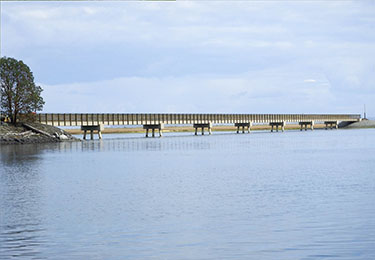|
Subscribe / Renew |
|
|
Contact Us |
|
| ► Subscribe to our Free Weekly Newsletter | |
| home | Welcome, sign in or click here to subscribe. | login |
News
| |
 |
September 29, 2016
Restoring an ecosystem? Get to know your geotech
Aspect Consulting

Holmson
|
A key goal of ecosystem restoration projects along Pacific Northwest waterways is to improve passage and habitat for salmon and other fish species.
Creating a healthier home for fish requires a multidisciplinary approach that addresses not just biological and ecological concerns, but also removing or replacing physical barriers blocking fishes’ path — be it an aging bridge, an undersized culvert, a road embankment impeding natural tidal influences, or a large quantity of earth disconnecting a floodplain.
Enter the geotechnical engineer.
While it may not always be apparent, geotechnical engineers are integral to restoration projects. Because their work is typically done far ahead of actual construction, it’s easy to boil down their role to drilling some holes, looking at the soil, and saying “build it this way.”
But a geotech’s work is much more and represents the basis for many elements of the larger project. By pursuing a proactive, collaborative mindset at project kickoff and integrating their work with those of other disciplines, geotechnical engineers can help projects move faster, be better informed and be more cost-efficient.
Know the goals
Early, holistic involvement by the geotechnical engineer to better understand project goals is important and often overlooked. It starts with a discussion with the owner and asking focused questions to gauge the project’s bigger picture. Is the project strictly for habitat restoration? Is it to increase flood storage? Are there transportation or recreational elements to consider? What are the civil and utility needs? Who are the stakeholders outside of the owners?
Take asking about the funding source, which often defines the design criteria. For example, if the Federal Highway Administration funds a project, some elements may be subject to strict seismic standards, which can be costly. If levees are involved and it is desired to certify them with Federal Emergency Management Agency criteria, they must be designed to a certain standard.
Asking these types of questions and knowing the owner’s answers can help geotechnical engineers know the project’s priorities and where they may be able to help other members of the design team.
Know the players
The next step is knowing who else will be working to achieve the project’s goals and which stakeholders may be affected by its outcome. Teams can be large and diverse. Communication between disciplines is often crucial to success.
Know the practice
Since their work is an important baseline for restoration projects, geotechnical engineers are often one of the first disciplines to break ground as they set out to collect information on the soil. Drilling borings, excavating test pits, conducting geophysical studies, or good old-fashioned shovel pits — these explorations help characterize the subsurface conditions that the team will use as the foundation for the rest of the project.
With a comprehensive understanding of the project and its players, geotechnical engineers can seek opportunities to execute an exploration program that benefits all aspects of the project.
Some ways geotechs can collaborate with other team members are:
• Collaborate early to understand the subsurface. Geotechs and archaeologists typically conduct subsurface investigations early. The archaeologists tend to explore many locations at shallow depths, whereas geotechs are more targeted but explore deeper into the ground.
If the geotech can coordinate to be on-site when the archaeologists are conducting their explorations and vice versa, each can see the conditions firsthand and document them for their respective purposes. Such cooperation creates a richer data set and better overall understanding of the subsurface conditions.
• Strategic siting to explore soil reuse and grain size. Restoration projects often have a habitat excavation area specifically for reconnecting the floodplain to the mainstem river or creek by creating a stream channel, pond, or a low area for a wetland.
By placing their explorations within these areas, geotechs can help characterize potential on-site borrow sources. This information lets construction crews know if they can reuse the soil they excavate as fill for levees or other project features.
The volume of earthwork on restoration projects can be significant, especially on larger projects such as levee setbacks or removals, and therefore costly. If borrow material comes from on-site, the material costs will be far less, resulting in significant savings. Knowing early on if the on-site borrow can be reused provides the most benefit to the project.
Explorations and sampling can also be adjusted to help gather information for geomorphologic analyses. For example, geotechs can plan to sample and analyze for sediment grain size from areas inside the proposed habitat excavation area.
Geomorphologists can use the results to help predict how the river or creek will flow and how that movement will affect the soil over time. The grain size also plays into the design of scour mitigation solutions, like riprap or engineered log jams.
Scour mitigation can help “train” the river to keep it from meandering into an undesired area or protect structure foundations like bridge abutments from scour.
• Add groundwater monitoring to learn how to cool the river. Select explorations can be finished with groundwater monitoring elements to characterize the hyporheic zone and inform side channel planning and recharge/up-welling estimates.
The hyporheic zone is the shallow groundwater zone near the ground surface that feeds streams/creeks/rivers with groundwater — it is important because it typically provides significant return flows to the streams that are usually cooler/cleaner (when compared to surface flows) and often a major benefit to fish habitat and conditions.
Geotechs can share their groundwater monitoring data with the biologists, hydrogeologists and geomorphologists who will use it to inform their recommendations on where best to locate a side channel, how it should be designed, and how it will move/scour and interact with other restoration features.
These examples illustrate considerations that are often outside of a typical geotechnical scope of work, which is usually limited to explorations and applied to specific structures like a levee, culvert or bridge. But adding these elements results in a more comprehensive and cohesive project design and construction.
Ultimately, the success of the overall project is dependent on the success of the individual task — just like the health of the ecosystem that geotechs are working to help restore.
Andrew Holmson, PE, is a senior geotechnical engineer at Aspect Consulting with 10 years of experience. He is lead geotechnical engineer on all of Aspect’s culvert/bridge replacement and levee modification/estuary restoration projects in the west Puget Sound area.
Other Stories:
- 3 things to consider about your building materials
- Survey: SoundEarth Strategies
- Survey: Coho Water Resources
- Survey: Landau Associates
- Survey: Shannon & Wilson
- Survey: Hart Crowser
- Still much to learn about the carbon story of buildings
- Robots go where no divers can to recover munitions
- Brownfields are becoming developers’ next frontier
- With Passive House, incentives are all carrot and no stick
- New water plant saves Lynden from the ‘milkshake effect’
- Reusing stormwater can release untapped benefits
- Navigating Washington’s water rights process
- Survey: Evergreen Certified



